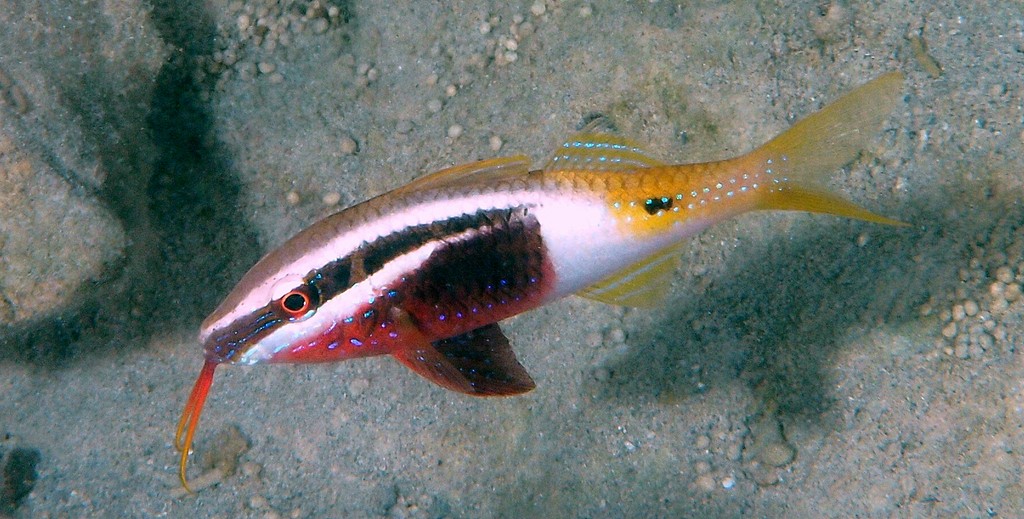PARUPENEUS BARBERINOIDES - (BLEEKER, 1852)
Actinopterygii (Gigaclass) > Actinopteri (Class) > Teleostei (Subclass) > Syngnathiformes (Order) > Mulloidei (Suborder) > Mullidae (Family) > Parupeneus (Genus)
Barbet moitié-moitié, Bicolor goatfish, Bicolour goatfish, Half-and-half goatfish, Swarthy-headed goatfish, Indo-himeji, インドヒメジ, 似条斑副绯鲤, 须海绯鲤,
Synonymes
Pseudopeneus barberinoides (Bleeker, 1852)
Upeneus atrocingulatus (Kner, 1870)
Upeneus barberinoides (Bleeker, 1852)
--------------------------
Description
Dorsal spines (total): 8; Dorsal soft rays (total): 9; Anal spine: 1; Anal soft rays: 7; Pectoral fin rays: 15-16 (usually: 15); Lateral line scales: 27-28; Gill rakers: 6-8 + 20-25 (total: 26-33). Body moderately elongate, depth: 3.2-3.5 in SL; Head length: 2.75-3.15 in SL; Snout length: 1.8-2.0 in HL; Barbel length: 1.3-1.5 in HL. Max. length: 30.0 cm TL, common length: 20.0 cm TL. Depth range: 1 - 40 m.
Color
Head and anterior half of body reddish black, posterior half white and yellow with a black spot nearly as large as eye on upper side below rear base of second dorsal fin, followed by small blue spots; A white band from front of snout passing above eye along dorsal part of body, and a second nearly parallel one from corner of mouth to above pectoral fin; Caudal fin pale yellow with a broad, dusky lower margin, and often with a small red spot at midbase; Barbels red.
Etymology
Parupeneus: from Latin prefixe, par = even (of a numbers), equal, like, suitable + the word, upeneus or upénéus. Georges Cuvier and Achille Valenciennes wrote in "Histoire Naturelle des poissons - 1829 - Tome troisième p447" that they chosed this word "upénéus" which it didn't have a specific meaning or sense in the ancient writes.
barberinoides: from latin, barbatulus = small fish belongin to Mullidae Family + from Latin suffix, –oides, having the form of.
Original description: Upeneus barberinoides Bleeker, 1852 - Type locality: Wahai, northern Ceram, Indonesia.
Distribution
Southeastern Indian Ocean, western Pacific: Indonesia, east to Caroline Islands and Samoa, north to Ryukyu and Ogasawara islands (Japan), south to northern Australia and New Caledonia.
Biology
Adults solitary, juveniles in schools. Usually found in the vicinity of coral reefs in protected waters such as bays or lagoons or in deeper outer-reef areas. Inhabits mixed sand, rubble, and seaweed covered bottoms. Carnivorous, feeds mainly on worms, crustaceans, brittle stars, and small mollusks and heart urchins. Aquarium fish.
Last update: 30, May 2024
Barbet moitié-moitié, Bicolor goatfish, Bicolour goatfish, Half-and-half goatfish, Swarthy-headed goatfish, Indo-himeji, インドヒメジ, 似条斑副绯鲤, 须海绯鲤,
Synonymes
Pseudopeneus barberinoides (Bleeker, 1852)
Upeneus atrocingulatus (Kner, 1870)
Upeneus barberinoides (Bleeker, 1852)
--------------------------
Description
Dorsal spines (total): 8; Dorsal soft rays (total): 9; Anal spine: 1; Anal soft rays: 7; Pectoral fin rays: 15-16 (usually: 15); Lateral line scales: 27-28; Gill rakers: 6-8 + 20-25 (total: 26-33). Body moderately elongate, depth: 3.2-3.5 in SL; Head length: 2.75-3.15 in SL; Snout length: 1.8-2.0 in HL; Barbel length: 1.3-1.5 in HL. Max. length: 30.0 cm TL, common length: 20.0 cm TL. Depth range: 1 - 40 m.
Color
Head and anterior half of body reddish black, posterior half white and yellow with a black spot nearly as large as eye on upper side below rear base of second dorsal fin, followed by small blue spots; A white band from front of snout passing above eye along dorsal part of body, and a second nearly parallel one from corner of mouth to above pectoral fin; Caudal fin pale yellow with a broad, dusky lower margin, and often with a small red spot at midbase; Barbels red.
Etymology
Parupeneus: from Latin prefixe, par = even (of a numbers), equal, like, suitable + the word, upeneus or upénéus. Georges Cuvier and Achille Valenciennes wrote in "Histoire Naturelle des poissons - 1829 - Tome troisième p447" that they chosed this word "upénéus" which it didn't have a specific meaning or sense in the ancient writes.
barberinoides: from latin, barbatulus = small fish belongin to Mullidae Family + from Latin suffix, –oides, having the form of.
Original description: Upeneus barberinoides Bleeker, 1852 - Type locality: Wahai, northern Ceram, Indonesia.
Distribution
Southeastern Indian Ocean, western Pacific: Indonesia, east to Caroline Islands and Samoa, north to Ryukyu and Ogasawara islands (Japan), south to northern Australia and New Caledonia.
Biology
Adults solitary, juveniles in schools. Usually found in the vicinity of coral reefs in protected waters such as bays or lagoons or in deeper outer-reef areas. Inhabits mixed sand, rubble, and seaweed covered bottoms. Carnivorous, feeds mainly on worms, crustaceans, brittle stars, and small mollusks and heart urchins. Aquarium fish.
Last update: 30, May 2024
